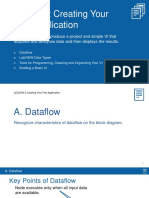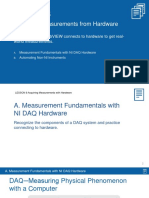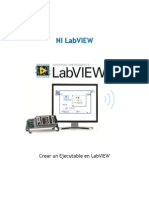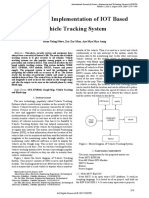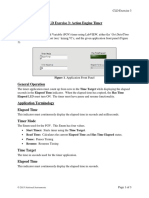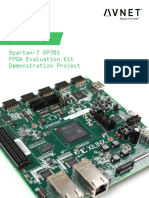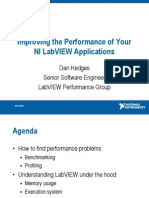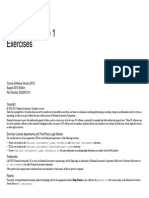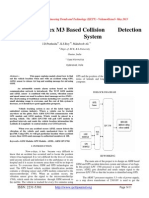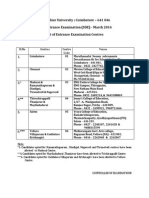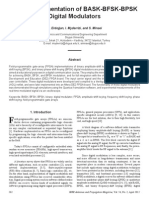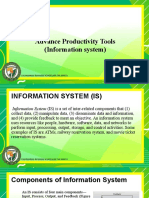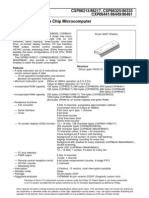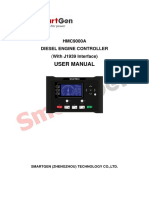NI CompactRIO Reconfigurable Control
and Acquisition Systems
��Introduction
National Instruments CompactRIO is a small rugged industrial control and acquisition
system powered by reconfigurable I/O (RIO) FPGA technology for ultrahigh performance
and customization. NI CompactRIO incorporates a real-time processor and reconfigurable
FPGA for reliable stand-alone embedded or distributed applications, and hot-swappable
industrial I/O modules with built-in signal conditioning for direct connection to sensors
and actuators. CompactRIO represents a low-cost architecture with open access to
low-level hardware resources. CompactRIO embedded systems are developed using
high-productivity LabVIEW graphical programming tools for rapid development. With
NI CompactRIO, you can rapidly build embedded control or acquisition systems that rival
the performance and optimization of custom-designed hardware circuitry.
The CompactRIO products include cRIO-9002 and cRIO-9004 real-time controllers with
industrial floating-point processors, the cRIO-910x family of 4 and 8-slot reconfigurable
chassis featuring 1 million or 3 million gate FPGAs, and a wide variety of I/O types, from
80 mV thermocouple inputs to 250 VAC/VDC universal digital inputs. CompactRIO
embedded systems are developed using LabVIEW, the LabVIEW Real-Time Module and
the LabVIEW FPGA Module. There are two configurations for CompactRIO embedded
systems and R Series expansion systems.
CompactRIO Reconfigurable Embedded System
A CompactRIO embedded system features a real-time embedded processor, 4 or 8-slot
reconfigurable chassis containing a user-programmable FPGA, and hot-swappable
industrial I/O modules. This low-cost embedded architecture delivers open access to
low-level hardware resources for rapid development of custom stand-alone or distributed
control and acquisition systems.
National Instruments Corporation
�CompactRIO R Series Expansion System
The CompactRIO R Series expansion system uses the same hot swappable industrial I/O
modules to provide high-performance signal conditioning and industrial expansion I/O for
PCI or PXI/CompactPCI R Series FPGA devices. The expansion system adds custom
measurement capabilities to applications that include traditional plug-in data acquisition,
vision, motion, and modular instrument devices.
Low-Cost Open Architecture
CompactRIO combines a low-power-consumption real-time embedded processor with a
high-performance RIO FPGA chipset. The RIO core has built-in data transfer mechanisms
to pass data to the embedded processor for real-time analysis, postprocessing, data logging,
or communication to a networked host computer. CompactRIO provides direct hardware
access to the input/output circuitry of each I/O module using LabVIEW FPGA elemental
I/O functions. Each I/O module includes built-in connectivity, signal conditioning,
conversion circuitry (such as ADC or DAC), and an optional isolation barrier. This design
represents a low-cost architecture with open access to low-level hardware resources.
ni.com
�I/O Modules
Each CompactRIO I/O module contains built-in signal conditioning and screw terminal,
BNC, or D-Sub connectors. By integrating the connector junction box into the modules, the
CompactRIO system significantly reduces the space requirements and cost of field wiring.
A variety of I/O types are available including 80 mV thermocouple inputs, 10 V
simultaneous sampling analog inputs/outputs, 24 V industrial digital I/O with up to 1 A
current drive, differential/TTL digital inputs with 5 V regulated supply output for encoders,
and 250 Vrms universal digital inputs. Because the modules contain built-in signal
conditioning for extended voltage ranges or industrial signal types, you can usually make
your wiring connections directly from the CompactRIO module to your sensors/actuators.
Visit ni.com/compactrio for the latest information on module availability.
Real-Time Processor
The CompactRIO embedded system features an industrial 200 MHz Pentium class
processor that reliably and deterministically executes your LabVIEW Real-Time
applications. Choose from thousands of built-in LabVIEW functions to build your
multithreaded embedded system for real-time control, analysis, data logging, and
communication. The controller also features a 10/100 Mb/s Ethernet port for programmatic
communication over the network (including e-mail) and built in Web (HTTP) and file
(FTP) servers. Using the remote panel Web server, you can automatically publish the
front-panel graphical user interface of your embedded application for multiclient remote
monitoring or control. The real-time processor also features dual 11 to 30 VDC supply
inputs, a user DIP switch, LED status indicators, a real-time clock, watchdog timers, and
other high-reliability features.
National Instruments Corporation
�Reconfigurable Chassis
The reconfigurable chassis is the heart of NI CompactRIO embedded systems, containing
the RIO FPGA core. This user-defined RIO FPGA is a custom hardware implementation
of your control logic, input/output, timing, triggering, and synchronization design. The RIO
FPGA chip is connected to the I/O modules in a star topology, for direct access to each
module for precise control and unlimited flexibility in timing, triggering, and
synchronization. A local PCI bus connection provides a high-performance interface
between the RIO FPGA and the real-time processor. The reconfigurable chassis features
the same rugged metal construction that characterizes the entire CompactRIO platform.
RIO Technology
With NI RIO technology, you define your own custom measurement hardware circuitry
using reconfigurable FPGA chips and LabVIEW graphical development tools. Now you
can take advantage of reconfigurable FPGA technology to automatically synthesize a
highly optimized electrical circuit implementation of your input/output, communication, or
control application.
Field-Programmable Gate Arrays (FPGAs)
FPGA devices are widely used by control and acquisition system vendors because of
their performance, reconfigurability, small size, and low engineering development costs.
FPGA based devices have been traditionally vendor defined rather than user defined
because of the complexity of the electronic design tools. Now you can take advantage
of user-programmable FPGAs to create highly optimized reconfigurable control and
acquisition systems with no knowledge of specialized hardware design languages such
ni.com
�as VHDL. With CompactRIO, you can design your own custom control or acquisition
circuitry in silicon with 25 ns timing/triggering resolution.
FPGA devices feature a reconfigurable digital architecture with a matrix of
configurable-logic blocks (CLBs) surrounded by a periphery of I/O blocks. Signals can
be routed within the FPGA matrix in any arbitrary manner by programmable interconnect
switches and wire routes. CompactRIO offers 4 and 8-slot chassis with options for either
1 million or 3 million gate FPGA chips.
Performance
Using LabVIEW FPGA software and reconfigurable hardware technology, you can create
ultrahigh performance control and acquisition systems with CompactRIO. The FPGA
circuitry is a parallel processing reconfigurable computing engine that executes your
LabVIEW application in silicon circuitry on a chip. You can design your own custom
control or acquisition circuitry in silicon with 25 ns timing/triggering resolution. LabVIEW
FPGA features built-in functions for analog closed-loop PID control, fifth-order FIR filters,
1D look-up tables, linear interpolation, zero-crossing detection, and direct digital synthesis
of sine waves.
Using the embedded RIO FPGA hardware, you can implement multiloop analog PID
control systems at loop rates exceeding 100 kS/s. Digital control systems can be
implemented at loop rates up to 1 MS/s, and it is possible to evaluate multiple rungs of
Boolean logic using single-cycle while loops at 40 MHz (25 ns). Due to the parallel nature
of the RIO core, adding additional computation does not necessarily reduce the speed of the
FPGA application.
National Instruments Corporation
�Size and Weight
CompactRIO is designed for applications in harsh environments and small places. Size,
weight, and I/O channel density are critical design requirements in many such embedded
applications. By taking advantage of the extreme performance and small size of FPGA
devices, CompactRIO is able to deliver unprecedented control and acquisition capabilities
in a compact, rugged package. A 4-slot reconfigurable embedded system measures
179.6 by 88.1 by 88.1 mm (7.07 by 3.47 by 3.47 in.) and weighs just 1.58 kg (3.47 lb).
An 8-slot system filled with 32-channel I/O modules delivers a mass channel density of
9.7 g/ch (0.34 oz/ch), and a volumetric channel density of 8.2 cm3/ch (0.50 in.3/ch).
Dimensions (4-slot)
179.6 by 88.1 by 88.1 mm
(7.07 by 3.47 by 3.47 in.)
Dimensions (8-slot)
274 by 88.1 by 88.1 mm
(10.79 by 3.47 by 3.47 in.)
Weight (4-slot, typical)
1.58 kg (3.47 lb)
Weight (4-slot, typical)
2.48 kg (5.46 lb)
Mass-Ch Density (8-ch module)
38.7 g/ch (1.37 oz/ch)
Volume-Ch Density (8-ch module)
32.9 cm3/ch (2.01 in.3/ch)
Mass-Ch Density (32-ch module)
9.7 g/ch (0.34 oz/ch)
Volume-Ch Density (32-ch module)
8.2 cm3/ch (0.50 in.3/ch)
NI CompactRIO Extreme Industrial Certifications and Ratings
CompactRIO is a reconfigurable embedded system that combines reliable stand-alone
embedded capability with extreme industrial certifications and ratings for operation in
harsh industrial environments. CompactRIO is rated for a 40 to 70 C (40 to 158 F)
temperature range, 50 g shock, and hazardous locations or potentially explosive
environments (Class I, Div 2). Most I/O modules feature up to 2,300 Vrms isolation
(withstand), and 250 Vrms isolation (continuous). Each component comes with a variety
of international safety, electromagnetic compatibility (EMC), and environmental
certifications and ratings. To find the industrial certifications and other specifications for
6
ni.com
�each device, refer to the operating instructions manual. Visit ni.com/hardref.nsf for
more information. 40 to 70 C (40 to 158 F) operating temperature
40 to 70 C (40 to 158 F) operating temperature
Up to 2,300 Vrms isolation (withstand)
50 g shock rating
International safety, EMC, and environmental certifications
Class I, Division 2 rating for hazardous locations
Dual 11 to 30 VDC supply inputs, low power consumption (7 to 10 W typical)
CompactRIO R Series Expansion System
In this configuration, a CompactRIO expansion chassis connects to the digital port on a PCI
or PXI R Series FPGA device. The R Series device can be installed in any desktop or PXI
computer system running Windows or one of the LabVIEW Real-Time OSs. The RIO
FPGA resides on the R Series device while CompactRIO converts a single digital port on
the R Series device into a high performance expansion I/O and signal conditioning system.
The Windows host CPU or PXI RT controller provides high-performance processing for
analog control, analysis, or hardware-in-the-loop (HIL) simulations. The R Series RIO
device and CompactRIO chassis provide high-speed signal conditioned input, output,
communication, and control capabilities and offer unprecedented flexibility and
optimization.
National Instruments Corporation
�R Series Expansion Chassis
The cRIO-9151 4-slot R Series expansion chassis connects directly to a PXI or PCI R Series
device such as the PXI-7831R, PXI-7811R, or PCI-7831R. In this configuration, the FPGA
resides on the R Series device and the CompactRIO I/O modules provides industrial I/O,
isolation, and signal conditioning. With the PXI-7831R or PCI-7831R, you can connect up
to two R Series Expansion Chassis for a maximum of eight I/O modules per R Series
device. With the PXI-7811R, you can connect up to four R Series expansion chassis for a
maximum of 16 I/O modules per R Series device.
ni.com
�Operating System Options for the CompactRIO R Series
Expansion System
A CompactRIO R Series expansion system can be used with a desktop or PXI computer
system running Windows or one of the LabVIEW Real-Time OSs. The National
Instruments LabVIEW Real-Time Module (version 7.1 and higher) accepts standard
desktop PCs as LabVIEW Real-Time targets. Visit ni.com/realtime for more
information on selecting your real-time deployment platform.
LabVIEW Real-Time (ETS)
LabVIEW Real-Time for ETS provides the greatest selection of PXI chassis, controllers,
and plug-in modules for data acquisition, vision, motion, modular instruments, and
industrial networking (CAN, GPIB, serial, etc.). In addition, the Dell Optiplex, Model
GX270 desktop computer has been validated to be fully functional with the LabVIEW
Real-Time Module and certain PCI based data acquisition and the R Series board,
PCI-7831R.
Controller
Processor
Ram (maximum)
PXI-8145 RT
266 MHz, Intel Pentium MMX
128 MB, DRAM
PXI-8175 RT
866 MHz, Intel Pentium III
512 MB, SDRAM
PXI-8176 RT
1.2 GHz, Intel Pentium III
512 MB, SDRAM
PXI-8186 RT
Mobile 2.2 GHz Intel Pentium 4
1 GB, DDR SDRAM
PXI-8187 RT
2.5 GHz Intel Pentium 4-M
1 GB, DDR SDRAM
LabVIEW Real-Time (RTX)
LabVIEW Real-Time for RTX can only be run on certain desktop computers and with a
limited selection of plug-in modules. RTX is an extension-based real-time OS that is
installed on the desktop PC to run alongside Windows 2000/XP. The RTOS extension
consists of a real-time kernel and a nonreal-time kernel sharing the same processor. With
this dual-kernel architecture, you can run both the host application and real-time system on
the same machine. To verify whether your PC is compatible with RTX, download the RTX
evaluation version from the Venturcom Website (http://www.vci.com/)
National Instruments Corporation
�Real-Time Control Application Design
Reconfigurable control and acquisition systems typically contain four major components:
RIO FPGA core application for input, output, communication, and control
Time-critical loop for floating-point control, signal processing, analysis, and
point-by-point decision making
Normal-priority loop for embedded data logging, remote panel Web interface, and
Ethernet/serial communication
Networked host PC for remote graphical user interface, historical data logging, and
postprocessing
Depending on your application requirements, you may decide to implement one or all of
these application components.
LabVIEW FPGA Module
LabVIEW and the LabVIEW FPGA Module deliver graphical development for FPGA
chips on NI RIO hardware. With the LabVIEW FPGA Module, you develop FPGA
applications on a host computer running Windows, and then LabVIEW compiles and
implements the code in hardware. Using the LabVIEW FPGA Module, you can define
custom I/O and control hardware circuitry without prior knowledge of hardware design or
VHDL. Graphical programming of FPGAs empowers LabVIEW users to synthesize their
own custom measurement circuitry that rivals the performance and optimization of
vendor-defined hardware.
10
ni.com
�Key Embedded System Developer Tools
The LabVIEW FPGA Module, LabVIEW Real-Time Module, and LabVIEW for Windows
development environments provide an array of tools and technologies to speed the
development of advanced, reliable, and highly optimized reconfigurable embedded
systems.
Embedded Project Manager
FPGA hardware target configuration and automatic module discovery
CompactRIO module and I/O channel alias name management
FPGA application flash memory download and autoload configuration
LabVIEW FPGA Development Environment
FPGA device I/O for analog input/output, digital input/output, and I/O property
nodes/methods
Interrupt (IRQ) generation and synchronization functions
40 MHz single-cycle timed loop for code execution in 25 ns timing interval
Parallel processing with while loop, sequence, case, for loop, and other execution
control structures
FPGA FIFO data buffering and memory read/write
Loop timer/counter with 40 MHz FPGA time base (25 ns tick, s, or ms resolution)
Boolean logic, comparison, numeric math, saturation arithmetic functions, and bitwise
data manipulation functions
HDL interface node for integration of non-LabVIEW IP cores
National Instruments Corporation
11
Nonlinear system and discrete linear control functions including PID and fifth-order
FIR filter
1D look-up table, linear interpolation, zero-crossing detection, and direct digital
synthesis sine generator
LabVIEW Real-Time Development Environment
Target configuration options including startup application execution settings and
development, Web, remote panel, and file server access
Open FPGA VI reference function for programmatic bit stream download,
communication interface reference, and application start
Deterministic real-time while loop thread synchronization with FPGA-generated
interrupt (IRQ)
FPGA front panel control/indicator read/write for data transfer
Data scaling/mapping functions for integer to floating-point engineering units
conversion
Real-Time FIFO data buffering
Timed loop structure for multirate deterministic control
Floating-point PID, set point profiling, gain scheduling, and rate limiter functions
Fuzzy logic control, continuous and discrete linear systems, and nonlinear systems, and
2D look-up table functions
Point-by-point signal generation, time-domain analysis, frequency-domain transforms
and spectrum analysis, filters, statistics, curve fitting/interpolation, linear algebra,
array/vector operations
SMTP E-mail, TCP/IP, UDP, IrDA, DataSocket, and VISA RS232 serial
programmatic server/client communication (including 802.11 wireless Ethernet)
Binary and text file I/O for embedded data logging and retrieval
Application Modules and Toolkits
12
LabVIEW PDA Module
LabVIEW Enterprise Connectivity Toolset
LabVIEW Remote Panel License-5 Users
LabVIEW Execution Trace Toolkit
LabVIEW Order Analysis Toolkit
LabVIEW Sound and Vibration Toolkit
LabVIEW Signal Processing Toolset
LabVIEW Simulation Module
LabVIEW Control Design Toolkit
LabVIEW System Identification Toolkit
LabVIEW Simulation Interface Toolkit
LabVIEW State Diagram Toolkit
ni.com
�LabVIEW Networked Host Application Development
Web browser remote panel graphical user interface plug-in for remote
control/monitoring (Windows, Linux, Mac OS X, Solaris)
Express spectral signal analysis, distortion/tone, amplitude/level, timing/transition,
convolution/correlation, mask/limit, histogram functions
Local or remote database connectivity, text/HTML/DIAdem report generation
Handheld mobile/portable PDA user interface/remote control (LabVIEW PDA
Module)
Application Examples
Because of its low cost, reliability, and suitability for high-volume embedded measurement
and control applications, CompactRIO can be adapted to solve the needs of a wide variety
of industries and applications. Examples include heavy industrial machine control,
in-vehicle data acquisition, machine condition monitoring, and rapid control prototyping
(RCP):
Batch control
Discrete control
Motion control
In-vehicle data acquisition
Machine condition monitoring
Rapid control prototyping (RCP)
Industrial control and acquisition
Distributed data acquisition and control
Mobile/portable noise, vibration, and harshness (NVH) analysis
CompactRIO is designed for advanced developers who will use LabVIEW graphical
development tools to adapt the reconfigurable hardware for a wide variety of industries and
applications. Customers such as MTS, Roush, Gpel, Process Automation and Virginia
Tech have already successfully developed CompactRIO embedded systems for heavy
machine control, in-vehicle data acquisition, acoustics and vibration analysis and electric
motor drive characterization.
Customer Successes
Automated Test Systems
Using RIO technology we reduced our development time by 50 percent, lowered our
systems cost by $40,000$150,000, and, best of all, enabled our customer to reuse 9095
percent of the platform for future applications.
Daren Williamson
AmFax Limited
National Instruments Corporation
13
�Transportation Research
In the quick-changing world of high-tech R&D, RIO technology provides us with a
tremendous advantage. Not only does RIO provide significant cost and time savings
compared to full custom solutions, but an even bigger benefit to our industry is that the
reconfigurability allows us to make rapid changes in response to redefinition of test plans
and project goals.
Corey Jaskolski
Hydro Technologies
Flight Data Acquisition
We found the CompactRIO-embedded system to be the ultimate solution for the extreme
environmental conditions of high altitude testing. Although most research aircrafts have
flight ceilings below 70,000 ft, for this test, we lowered the pressure to the lower limit of
the bell jar operating range. CompactRIO performed flawlessly even at this extreme.
David Thomson, Researcher
National Oceanic and Atmospheric Administration (NOAA)
Portable Noise, Vibration, and Harshness Testing
This is another step forward in MTS cooperation with NI to help customers standardize
noise and vibration testing. CompactRIO complements our product offerings for noise and
vibration testing, allowing customers to further standardize user interfaces to accommodate
multiple, unique testing scenarios. This supports our long-term goal of bringing a new level
of affordability, flexibility and productivity to noise and vibration testing.
Doug Marinaro, Vice President
MTS Software & Consulting
Industrial Process and Motion Control
For this application, CompactRIO is extremely critical. Our embedded MFA controllers
running in LabVIEW Real-Time now offer an off-the-shelf high-speed and high accuracy
adaptive control solution matched only by custom hardware. CyboSoft MFA controllers
running in CompactRIO offer high-speed control loop rates of 100 s with 16-bit analog
I/O accuracy.
Dr. George Cheng, CEO
CyboSoft
In-Vehicle Data Acquisition (Chassis/Body Dynamics)
Using our extensive LabVIEW expertise and NI's new CompactRIO platform, we created
an intelligent vehicle dynamics data acquisition application, in one-fourth the time that it
would have taken to create custom hardware from scratch. We chose CompactRIO because
no other solution on the market offers this level of customization in a form factor rugged
enough to withstand the harsh terrain of modern proving grounds. Because we can easily
14
ni.com
�make changes to our application in LabVIEW, we can reconfigure our system in a matter
of days....not weeks.
Joel Gorsegner, Development Engineer
Roush Industries, Inc.
Heavy Machine Control
A short beta test of CompactRIO provided proof positive testing that this platform would
meet all of the project requirements. Coupled with National Instruments reputation for solid
performing technology and high value to dollar ratio, the CompactRIO platform emerged
as the most cost-effective platform for this application. The CompactRIO system provides
enough processing horsepower to allow multiple fastener installation tools to operate off of
a single CompactRIO chassis. This made CompactRIO over twice as cost-effective as the
previous system.
Greg Sussman
Process Automation Corp
In-Vehicle Data Acquisition (Electronics Test)
The advantage of National Instruments CompactRIO is its small size and flexibility. Our
development department transferred this flexibility to the CARLOS system. With
CompactRIO, we created highly customized algorithms to integrate into CARLOS,
delivering a portable, user-defined onboard vehicle analysis and diagnostics system.
Rainer Lindner
GPEL electronic GmbH
Automotive Rapid Control Prototyping (RCP)
Using our existing powertrain control and LabVIEW expertise, we prototyped a
full-authority engine control system with CompactRIO to control a high-performance
motorcycle engine in just three man-months. In past projects, it took us at least two
man-years and over $500,000 to develop similar ECU systems with custom designed
hardware. With CompactRIO, we ran deterministic loops on the order of milliseconds and
performed FPGA-based fuel and spark timing on the order of microseconds. In addition,
we could easily add sensors and actuators, or otherwise modify our system, with minimal
time investment.
Carroll G. Dase, President
Drivven, Inc.
Electric Motor Drive Research
Using LabVIEW software and CompactRIO modules, we built a successful solution for
measuring the full magnetization characteristics of a switched reluctance (SR) machine.
CompactRIO provided a user-friendly tool for accurate experimental data measurement,
and allowed our research group to eliminate error from eddy current losses and resistance
changes due to heating.
Keunsoo Ha, Researcher
Virginia Tech Motion Control Systems Research Group
National Instruments Corporation
15
�Build your CompactRIO System
Table 1. Step 1. Choose your CompactRIO Real-Time Embedded Controller, PXI Controller, or Desktop PC.
Type of Controller
Reconfigurable Embedded System
R Series Expansion System
Standard real-time
cRIO-9002 embedded controller,
64 MB storage
PXI-8145 RT, PXI-1031
(real-time PXI)
Premium real-time
cRIO-9004 embedded controller,
512 MB storage
PXI-8186 RT, PXI-1031
(real-time PXI)
Windows PXI
NI PXI-8186, PXI-1031
Windows desktop
Windows desktop
Desktop real-time (RTX)
Certified desktop PC
(Dell Optiplex, model GX270)
Table 2. Step 2. Select a REconfigurable Embedded Chassis or R Series Device and Expansion Chassis.
Type of Chassis
Reconfigurable Embedded System
R Series Expansion System
Standard real-time
cRIO-9101 4-slot 1 M gate RIO chassis
cRIO-9102 8-slot 1 M gate RIO chassis
PCI-7831R or PXI-78x1R, and
cRIO-9151 expansion chassis
Premium real-time
cRIO-9103 4-slot 3 M gate RIO chassis
cRIO-9104 8-slot 3 M gate RIO chassis
PCI-7831R or PXI-78x1R, and
cRIO-9151 expansion chassis
Windows PXI
PXI-7831R or PXI-7811R and
cRIO-9151 expansion chassis
Windows desktop
PCI-7831R and
cRIO-9151 expansion chassis
Desktop real-time
(RTX)
PCI-7831R and
cRIO-9151 expansion chassis
16
ni.com
�Table 3. Step 3. Choose your I/O modules.
Module
Channels
Special Features
cRIO-9211
24-Bit Delta-Sigma, 15 S/s, Differential
(J, K, R, S, T, N, E, and B thermocouple types)
IEPE2 (5 V)
cRIO-9233
24-bit delta-sigma, 50 kS/s per ch,
simultaneous, antialiasing, nonisolated, TEDS
Small voltage
(80 mV)
cRIO-9211
24-bit, 15 S/s, differential
cRIO-9215
16-Bit, 100 kS/s per ch, simultaneous,
differential
cRIO-9201
12-bit, 400 kS/s
High voltage
(60 V)
cRIO-9221
12-bit, 800 kS/s
Medium voltage
(10 V)
cRIO-9263
16-bit, 100 kS/s per ch, simultaneous
24 V sinking
cRIO-9421
100 s, 24 V logic, 40 V protection
cRIO-9423
1 s, high-speed, 24 V logic, 35 V protection
250 AC/DC
universal
cRIO-9435
3 ms, 5 to 250 VDC, 10 to 250 VAC, universal,
sink/source
Differential or
TTL
cRIO-9411
1 s, 5 to 24 V, single-ended TTL or
differential, regulated 5 V supply output
cRIO-9472
100 s, 24 V logic, 750 mA max per ch, 30 V
protection, short-circuit-proof
cRIO-9474
1 s, high-speed, 24 V logic, 1 A max per ch, 30
V protection, short-circuit-proof
Form A (SPST)
cRIO-9481
1 s, 30 VDC (2 A), 60 VDC (1 A), 250 VAC (2
A) electromechanical form A (SPST)
Counter/timer
(24 V)
cRIO-9423
1 s, high-speed, 24 V logic, 35 V protection
Counter/timer
(TTL)
cRIO-9411
1 s, 5 to 24 V, single-ended TTL or
differential, regulated 5 V supply output
Quadrature
encoder
(differential)
cRIO-9411
1 s, 5 to 24 V, single-ended TTL or
differential, regulated 5 V supply output
PWM (5 to 30 V)
cRIO-9474
1 s, high-speed, 24 V logic, 1 A max per ch, 30
V protection, short-circuit-proof
Counter, Pulse
Relay
Output
Digital
Output
Analog Input
Thermocouple
Analog
Output
Signal
Digital Input
Type of
Signal
Medium voltage
(10 V)
24 V sourcing
National Instruments Corporation
17
� 2004 National Instruments Corporation. All rights reserved.
CompactRIO, LabVIEW, National Instruments, and ni.com are trademarks of National Instruments Corporation. Product and company names
mentioned herein are trademarks or trade names of their respective companies. For patents covering National Instruments products, refer to the
appropriate location: HelpPatents in your software, the patents.txt file on your CD, or ni.com/patents.
Aug04
342480A-01
*342480A-01*
11500 North Mopac Expressway Austin, TX 78759-3504 USA
Tel: (512) 683-0100 Fax: (512) 794-8411 Email: info@ni.com












